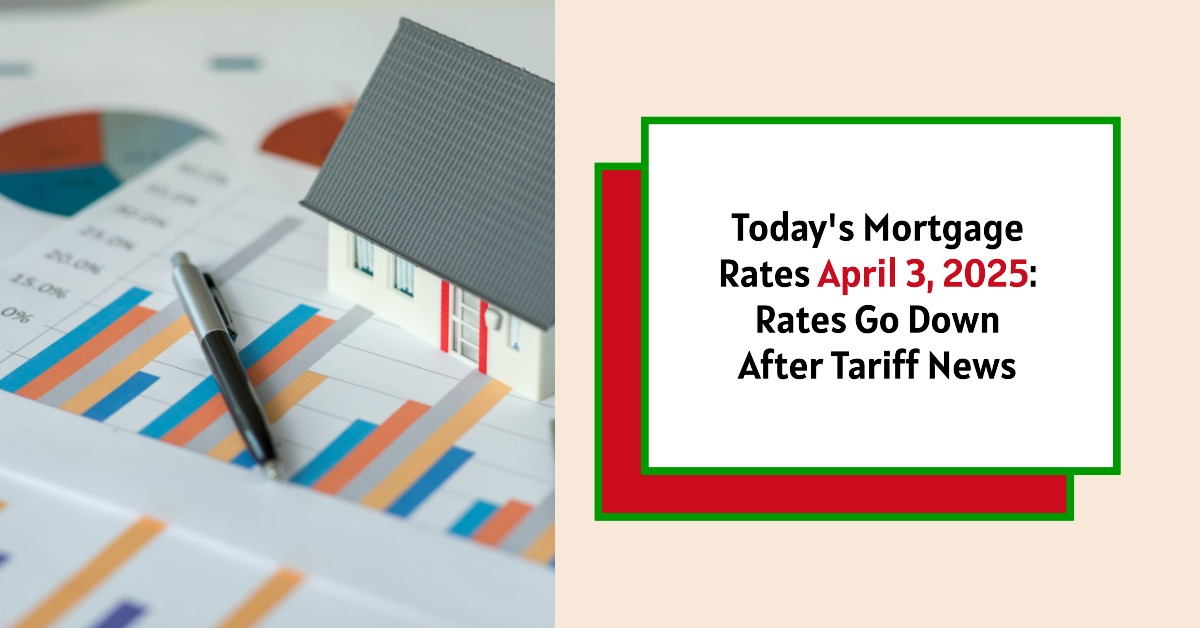As of April 3, 2025, mortgage rates have dipped slightly to around 6.40%, influenced by recent economic events, including tariff announcements from the White House. This decline is relevant for both new mortgage borrowers and those considering refinancing their existing loans. With this in mind, let’s explore current rates, what they mean for you, and the broader economic context shaping these changes.
Today's Mortgage Rates April 3, 2025: Rates Go Down After Tariff News
Key Takeaways
- Current Mortgage Rate: Approximately 6.40% for a 30-year fixed-rate mortgage.
- Refinance Rates: Average rate for 30-year fixed refinance is about 6.48%.
- Economic Influences: Rates decreased due to economic uncertainties and tariff announcements.
- Rate Trends: The market might see fluctuations as economic conditions evolve.
Understanding Today's Mortgage Rates
Mortgage rates are crucial in determining how much you’ll pay for a home over the life of your loan. As of today, here are the average rates from Zillow:
| Mortgage Type | Average Rate |
|---|---|
| 30-Year Fixed-Mortgage | 6.56% |
| 20-Year Fixed Mortgage | 6.22% |
| 15-Year Fixed Mortgage | 5.90% |
| 7/1 Adjustable Rate Mortgage | 6.49% |
| 5/1 Adjustable Rate Mortgage | 6.63% |
| 30-Year FHA Mortgage | 5.95% |
| 30-Year VA Mortgage | 6.02% |
For refinancing, rates are similarly competitive. Here’s a snapshot of current refinance rates:
| Refinance Type | Average Rate |
|---|---|
| 30-Year Fixed Refinance | 6.48% |
| 20-Year Fixed Refinance | 6.18% |
| 15-Year Fixed Refinance | 5.92% |
| 7/1 ARM Refinance | 6.41% |
| 5/1 ARM Refinance | 6.67% |
| 30-Year FHA Refinance | 6.02% |
| 30-Year VA Refinance | 6.50% |
These rates indicate a minor decrease compared to recent averages, where the 30-year fixed mortgage was around 6.45% in March.
Current Economic Context
The recent dip in rates can be attributed to the announcement of tariffs by President Donald Trump, who proposed a 10% tariff on imports, impacting market stability and investor confidence. When tariffs are introduced on imported goods, they can complicate the economy, potentially sparking fears of a recession. As a result, the bond market responded by lowering the 10-year Treasury yield, which is typically linked with mortgage rates.
The concern following these tariff announcements is twofold. First, while it may lead to a temporary decrease in mortgage rates, it could also result in an uptick in inflation. If inflation rises, it could negate any benefits gained from the lowered mortgage rates, creating a complex environment for homebuyers and investors. It's vital to stay updated on these developments as they unfold, as they have direct implications for affordability in the housing market.
A Closer Look at Mortgage Types and Rates
30-Year Fixed Mortgage
The 30-year fixed-rate mortgage remains the most popular option for homebuyers and is currently averaging 6.56%. This type of mortgage allows borrowers to repay their loan over 30 years, providing stability and predictability in monthly payments.
Utilizing an example, if a homebuyer takes out a mortgage of $300,000 at a 6.56% interest rate, the monthly payment would be approximately $1,896. Initially, a large portion of this payment would cover interest, but as time progresses, a greater portion will go toward the principal.
Here’s a breakdown of what the monthly payments might look like in the early years versus later years:
- Year 1:
- Monthly Payment: $1,896
- Interest in First Payment: $1,553
- Principal Payment: $343
- Year 10:
- Monthly Payment: $1,896
- Interest Portion: $1,372
- Principal Payment: $524
As illustrated, the longer you hold the mortgage, the more your payments will contribute to the principal rather than just interest.
15-Year Fixed Mortgage
The 15-year fixed-rate mortgage is also a popular choice, especially among buyers looking to minimize interest costs. Currently averaging around 5.90%, this option allows for quicker equity building in the home and is preferable for those who can handle larger monthly payments.
For our example of a $300,000 mortgage at 5.90%, the monthly payment calculates to approximately $2,537, significantly more than a 30-year loan but with one key benefit: the total interest paid over life of the loan is substantially less.
Here’s what the payment breakdown might look like for the 15-year mortgage:
- Year 1:
- Monthly Payment: $2,537
- Interest in First Payment: $1,473
- Principal Payment: $1,064
- Year 5:
- Monthly Payment: $2,537
- Interest Portion: $949
- Principal Payment: $1,588
The strategy with shorter-term loans like the 15-year option is to pay less interest overall, allowing homeowners to cleanly pay off their mortgage sooner.
Why Refinance Now?
While it might not seem the perfect moment to refinance due to rates still being relatively high, if you are currently paying a significantly higher interest rate, it could still be worthwhile. Homeowners with interest rates above 6.50% might find substantial savings by refinancing at today’s rates.
Consider this simple scenario:
- Current Mortgage Amount: $300,000 at 6.75% interest
- Monthly Payments: Approximately $1,948
- New Rate with Refinance: 6.40%
- New Monthly Payments: Approximately $1,896
In this situation, refinancing would lower monthly payments, and those savings could be substantial over time. This demonstrates how refinancing under favorable conditions can significantly benefit homeowners.
Influences on Mortgage Rates
Several factors determine mortgage rates:
- Economic Trends: Insights from economic data such as inflation rates, employment figures, and overall consumer spending can heavily influence mortgage rates. The anticipation of continued inflation can lead to higher mortgage rates, impacting affordability.
- Federal Reserve Policy: The Federal Reserve's decisions concerning interest rate changes tend to influence mortgage rates indirectly. As the Fed raised the federal funds rate through 2022 and 2023, it aimed to control inflation. The expectation of further cuts to combat a potential recession could shape future mortgage rates.
- Personal Factors: Lenders assess individual financial profiles, such as credit scores, employment statuses, and down payment sizes. Borrowers who make efforts to improve their credit scores can significantly affect the rates they qualify for.
Recommended Read:
Mortgage Rates Trends as of April 2, 2025
Will Mortgage Rates Go Down in April 2025? Here's What the Experts Say
Expect High Mortgage Rates Until 2026: Fannie Mae's 2-Year Forecast
Future Predictions on Mortgage Rates
Looking ahead, experts anticipate that mortgage rates will ease as the economy stabilizes. However, major fluctuations in inflation, tariffs, and broader economic policies will be key determinants in that trajectory. While rates may dip slightly more in the near term, they are not expected to plummet back to the historic lows seen in 2020 and 2021.
Current predictions suggest a stabilization around 6% to 6.5%, but keep in mind these estimations are influenced by unfolding economic conditions. It's essential to remain informed about potential shifts that could impact consumer confidence and buying power.
How to Navigate the Mortgage Process Today
As prospective homebuyers or refinancers consider securing a mortgage during these fluctuating rates, being informed is crucial. Here are essential strategies for navigating the mortgage landscape:
- Stay Informed: Regularly check mortgage rate fluctuations and economic trends. Understanding market movements empowers you to make informed decisions.
- Shop Around: Lenders often provide a range of rates and terms. Reach out to multiple lenders, and don’t hesitate to negotiate terms based on the offers you receive. Getting pre-approved can provide a clearer picture of your options.
- Understanding Fees: Be thorough in understanding any lender fees associated with obtaining a mortgage. Ensure that the overall cost of the loan, including fees, is justified by the rates being offered.
- Consider Timing: Although rates are fluctuating, timing your mortgage application can save you money. If you feel confident about potential declines in rates, it may be worth waiting. Conversely, if you find a rate that meets your needs, moving forward could be beneficial.
- Use Technology: Online mortgage calculators are powerful tools to project your potential mortgage payments based on different rates, terms, and loan amounts. They help you visualize your long-term commitment.
Summary:
Today’s mortgage rates reflect a slight decrease in light of recent economic developments. Keeping an eye on these rates and understanding the underlying influences can help inform your decisions, whether you are purchasing a new home or refinancing. Staying proactive and well-informed is essential in today’s financial climate, enabling you to navigate the intricacies of mortgage financing effectively.
Work With Norada, Your Trusted Source for
Real Estate Investment in the U.S.
Investing in turnkey real estate can help you secure consistent returns with fluctuating mortgage rates.
Expand your portfolio confidently, even in a shifting interest rate environment.
Speak with our expert investment counselors (No Obligation):
(800) 611-3060
Also Read:
- Will Mortgage Rates Go Down in 2025: Morgan Stanley's Forecast
- Mortgage Rate Predictions 2025 from 4 Leading Housing Experts
- Mortgage Rates Forecast for the Next 3 Years: 2025 to 2027
- 30-Year Mortgage Rate Forecast for the Next 5 Years
- 15-Year Mortgage Rate Forecast for the Next 5 Years
- Why Are Mortgage Rates Going Up in 2025: Will Rates Drop?
- Why Are Mortgage Rates So High and Predictions for 2025
- Will Mortgage Rates Ever Be 3% Again in the Future?
- Mortgage Rates Predictions for Next 2 Years
- Mortgage Rate Predictions for Next 5 Years
- Mortgage Rate Predictions: Why 2% and 3% Rates are Out of Reach
- How Lower Mortgage Rates Can Save You Thousands?
- How to Get a Low Mortgage Interest Rate?
- Will Mortgage Rates Ever Be 4% Again?


